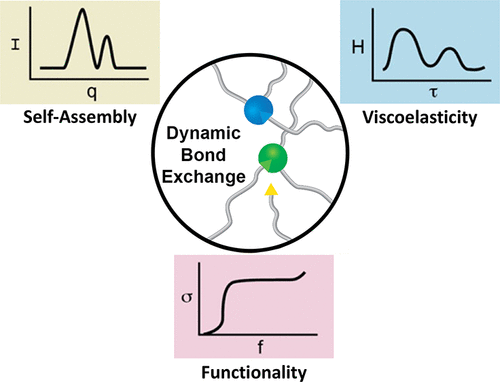当前位置:
X-MOL 学术
›
ACS Macro Lett.
›
论文详情
Our official English website, www.x-mol.net, welcomes your
feedback! (Note: you will need to create a separate account there.)
Vitrimers: Using Dynamic Associative Bonds to Control Viscoelasticity, Assembly, and Functionality in Polymer Networks
ACS Macro Letters ( IF 5.1 ) Pub Date : 2022-03-21 , DOI: 10.1021/acsmacrolett.2c00038 Laura Porath 1, 2 , Bhaskar Soman 1, 2 , Brian B Jing 1, 2 , Christopher M Evans 1, 2, 3
ACS Macro Letters ( IF 5.1 ) Pub Date : 2022-03-21 , DOI: 10.1021/acsmacrolett.2c00038 Laura Porath 1, 2 , Bhaskar Soman 1, 2 , Brian B Jing 1, 2 , Christopher M Evans 1, 2, 3
Affiliation

|
Vitrimers have been investigated in the past decade for their promise as recyclable, reprocessable, and self-healing materials. In this Viewpoint, we focus on some of the key open questions that remain regarding how the molecular-scale chemistry impacts macroscopic physical chemistry. The ability to design temperature-dependent complex viscoelastic spectra with independent control of viscosity and modulus based on knowledge of the dynamic bond and polymer chemistry is first discussed. Next, the role of dynamic covalent chemistry on self-assembly is highlighted in the context of crystallization and nanophase separation. Finally, the ability of dynamic bond exchange to manipulate molecular transport and viscoelasticity is discussed in the context of various applications. Future directions leveraging dynamic covalent chemistry to provide insights regarding fundamental polymer physics as well as imparting functionality into polymers are discussed in all three of these highlighted areas.
中文翻译:

Vitrimers:使用动态缔合键控制聚合物网络中的粘弹性、组装和功能
在过去的十年中,Vitrimers 因其作为可回收、可再加工和自我修复材料的前景而受到调查。在这个观点中,我们关注一些关于分子尺度化学如何影响宏观物理化学的关键开放性问题。首先讨论了基于动态键和聚合物化学知识,设计具有独立控制粘度和模量的温度相关复杂粘弹性谱的能力。接下来,在结晶和纳米相分离的背景下,强调了动态共价化学对自组装的作用。最后,在各种应用的背景下讨论了动态键交换操纵分子传输和粘弹性的能力。
更新日期:2022-03-21
中文翻译:

Vitrimers:使用动态缔合键控制聚合物网络中的粘弹性、组装和功能
在过去的十年中,Vitrimers 因其作为可回收、可再加工和自我修复材料的前景而受到调查。在这个观点中,我们关注一些关于分子尺度化学如何影响宏观物理化学的关键开放性问题。首先讨论了基于动态键和聚合物化学知识,设计具有独立控制粘度和模量的温度相关复杂粘弹性谱的能力。接下来,在结晶和纳米相分离的背景下,强调了动态共价化学对自组装的作用。最后,在各种应用的背景下讨论了动态键交换操纵分子传输和粘弹性的能力。











































 京公网安备 11010802027423号
京公网安备 11010802027423号